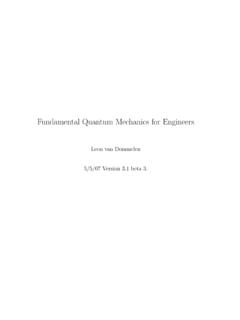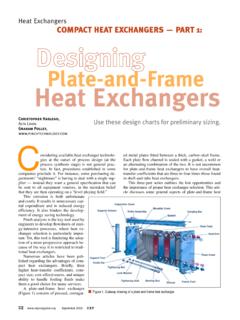Transcription of 5. FLOW IN THE CYLINDER - University of Thessaly
1 5. FLOW IN THE CYLINDER . by John L. Lumley, Cornell University (excerpt from his book: Engines an introduction. Cambridge University Press, 1999). INTRODUCTION. The gas flow in the CYLINDER has a profound influence on the performance of the engine, whether intended or not. In the early days of the automobile, it was seldom intended, because relatively little was understood about turbulence, the primary player in this drama. Engines were designed largely by empiricism; from time to time a particularly successful design emerged, and its characteristics (to the extent that their relevance was recognized) were preserved in subsequent engines.
2 There are a couple of notable exceptions to this: In the first, between 1903 and 1907 H. R. Ricardo [45] (the father of the octane number), working at Cambridge University with Professor Bertram Hopkinson, did pioneering work on the effect of turbulence on combustion and heat transfer in the IC engine, particularly on the effect of the increased effective flame speed on knock, and on the possibility of stratified charge, among other things. This led, during the First World War, to great improvements in the design of tank engines (giving short flame travel and high turbulence levels, permitting higher compression ratios without knock), and after the war led to design modifications of the flat head, or side valve engine, which resulted in the same performance as the overhead valve engine, and which were generally adopted, and resulted in patents.
3 The other notable exception involved measurements made of the swirl and tumble produced by various inlet configurations, and the effect of the swirl and tumble on combustion [63], [86]. The flow measurements were made using high speed photography of goose down (!) in a glass CYLINDER . The combustion measurements used schlieren techniques. The authors determined the major mean flow and turbulent characteristics of swirl and tumble, and their effects on combustion (we will detail this later). The work of Ricardo (above) and this pre war work were largely forgotten, and had to be rediscovered during the 1980s and 1990s.
4 An example of an early engine designed largely on an empirical basis is the DOHC penta head engine, which was developed for racing during the teens of the century, and was afterward extensively used in aircraft. It was designed principally to maximize the valve area, which keeps the Mach index as low as possible, although the Mach index was not understood at the time. It was known to be particularly successful, but it was not understood until recently (except for the work of Ricardo [45] and the NACA work [63], [86]) that the orientation of the inlet valves induces tumble, which is then broken up as the piston approaches TC, resulting in high turbulence levels, and high effective flame speeds.
5 The central location of the spark plug also gives relatively short travel distances for the flame front, which Ricardo [45] understood. The combination of short distances and high effective speeds results in short burn times, which means that the compression ratio can be increased at the same octane number without knock, one of Ricardo s basic findings [45]. In modern engines, short burn times can be taken advantage of in other ways. For example, higher exhaust gas recirculation rates (EGR) could be tolerated, resulting in higher efficiency and lower NOx production.
6 This would be preferable to increasing the compression ratio in a modern engine, since an increased compression ratio could raise the unburned hydrocarbon emissions, because the crevice volume would become a larger fraction of the total volume. We will discuss all these possibilities in due course. Now, engines are designed in an attempt to consciously bring about some of these effects. Unfortunately, our ability to apply existing limited understanding of fluid 1 mechanics and turbulence to the complicated situation in the CYLINDER is still fairly rudimentary, and while the process is more rational and less empirical than it used to be, it still has some way to go.
7 Also, engine designers are trying to do rather ambitious things. These come under the general heading of flow management, with the goal of reducing brake specific fuel consumption and emissions. There is a complex interaction among the flow management, the characteristics of the catalyst, the emissions, and the fuel consumption. For example, the lean burn engine burns a homogeneous mixture of perhaps 24:1. Such a mixture is relatively difficult to burn, and requires a high turbulence level. Exhaust gas recirculation (EGR) is another technique to meet the same goal.
8 EGR keeps approximately the same proportions, but replaces some of the excess air with recirculated exhaust gas, which has the advantage that a 3 way catalyst remains effective (current catalysts are not effective when the gases contain an excess of oxygen). Again, high turbulence levels are required to obtain reliable combustion. The stratified charge engine attempts to segregate the incoming fuel vapor so that it does not mix with all the air in the CYLINDER , so that the engine will run at an effective air/fuel ratio of perhaps 50:1, while the fuel is confined to a small region of the CYLINDER volume where the air/fuel ratio is only 15:1, which will ignite and burn.
9 Stratified charge engines now are direct injection engines; that is, they inject the fuel spray at high pressure directly into the CYLINDER , using various strategies to keep the fuel spray from mixing with the entire contents of the CYLINDER . In the early development (say, twenty years ago) of the stratified charge engine, various techniques (other than direct injection) were used to segregate the charge, and they were not very effective. We will discuss some of these techniques later. Such engines did not achieve air/fuel ratios much above those of the lean burn engines, and are now thought to have been probably about as homogeneous as a poorly managed homogeneous charge engine.
10 Terms like nearly homogeneous, or weakly stratified might better be used to describe these engines. The suggestion here is, that homogeneous charge engines, unless considerable care be taken to induce homogeneity, are not particularly homogeneous. Lean burn results in a lower combustion temperature overall, producing fewer oxides of nitrogen. Because the mixture is approximately stoichiometric or slightly rich in the fuel cloud in the stratified charge engine, the oxides of nitrogen are no lower than those of the lean burn engine, although the air/fuel ratio may be much higher.








